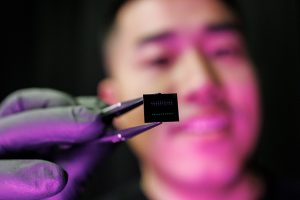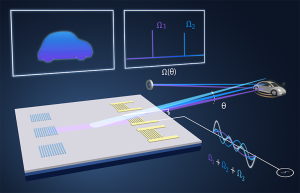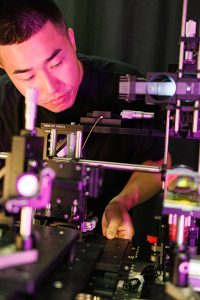By Wayne Gillam / UW ECE News

UW ECE alumnus Bingzhao Li (Ph.D. ‘22) has received an Activate Fellowship to commercialize compact, affordable LiDAR technology he helped to develop in the UW Laboratory of Photonic Systems, which is directed by UW ECE and Physics Professor Mo Li. Shown above: Bingzhao holds the LiDAR system microchip he and Professor Li engineered in the lab. Photo by Ryan Hoover / UW ECE
Light detection and ranging, or LiDAR, is a remote sensing technology used for creating high-resolution 3D maps and models of the environment. It has many uses and can provide valuable information beyond what can be seen with a conventional camera. For example, self-driving cars can use LiDAR to detect pedestrians and other obstacles in their path that are difficult to see; LiDAR enables robots to perceive their surroundings, navigate complex spaces, and interact with objects; and LiDAR is useful for mapping complex terrain by those in forestry, mining, archaeology, construction, traffic control, and urban planning.
But current LiDAR systems rely on bulky mechanical components that prevent widespread adoption in compact applications. While LiDAR technology delivers superior accuracy and reliability for 3D perception, existing systems are too large, heavy, and expensive for smaller devices that need to be mobile and versatile.
UW ECE alumnus Bingzhao Li (Ph.D. ‘22) has been working on this issue with UW ECE and Physics Professor Mo Li (no family relation) since 2020, when the pair first came up with an idea for improving LiDAR systems during the coronavirus pandemic. Professor Li is also a member of the Institute for Nano-Engineered Systems, and a member of QuantumX at the UW, which pioneers development of quantum-enabled technology.
“The idea started during the COVID-19 lockdown, when we did not have access to our lab,” Bingzhao said. “During a meeting on Zoom, Professor Li and I first conceived the idea with a simple sketch on paper, and as soon as our lab reopened, we quickly turned it into a significant research result. Now, we want to turn it into a product.”

Bingzhao Li is a research scientist in the UW Laboratory of Photonic Systems as well as a co-founder and chief executive officer of a new startup, LEAP Photonics. Photo courtesy of Bingzhao Li
Bingzhao has been learning from and working with Professor Li for a long time — first as an undergraduate student in an electromagnetics course taught by Professor Li, then later, as a graduate student in Professor Li’s research group. After receiving his doctoral degree from UW ECE, Bingzhao continued to work with Professor Li as a postdoctoral research fellow. Today, Bingzhao is a research scientist in Professor Li’s UW Laboratory of Photonic Systems, where he investigates integrated photonic devices, optoelectronic materials, and quantum photonics.
Over the last five years, and working alongside UW ECE graduate student Qixuan Lin, Bingzhao and Professor Li have developed new technology for LiDAR systems that is much more compact and affordable than what is currently available in the marketplace. Their work has been described in the June 2023 issue of the journal Nature, and recently, in the May 2025 issue of Nature Communications.
At the core of their innovative technology is a laser-beam steering device that is about 1,000 times smaller than what is commercially available today. The device is integrated into a microchip, which makes it compact, easy to fabricate, and affordable to produce. The chip allows engineers to eliminate bulky mechanical components, enabling production of a sturdy, solid-state LiDAR system that is much smaller and lighter than current models on the market, while also significantly reducing production costs. This compact and affordable technology for LiDAR systems can be used in a wide range of applications, including self-driving vehicles, drones, traffic control systems, and robotic systems found in agriculture, global supply chains, and medical imaging.
“UW ECE releases a lot of commercial technology, and this LiDAR technology is a good example of that. Bingzhao was my student first, then he became a postdoc, and now he is an entrepreneur based in the Department. So, this is a UW ECE success story.”
— UW ECE and Physics Professor Mo Li
The technology Bingzhao and Professor Li have developed has attracted attention, funding, and support since they published their work in 2023. They have received grants from the National Science Foundation, the Defense Advanced Research Projects Agency (DARPA), the Washington Research Foundation (Technology Commercialization grant in phase 1 and 2), and UW CoMotion, which, in addition to providing a CoMotion Innovation Gap Fund award, helped them to file and license the patents for their technology.
In June 2023, Bingzhao received the Yang Award for Outstanding Doctoral Student at UW ECE for his research in optics and photonics, which included his work on technology for LiDAR systems. Now, Bingzhao has been awarded a 2025 Activate Fellowship to commercialize this technology and turn it into a marketable product.
The Activate Fellowship and LEAP Photonics

LEAP Photonics’ product for LiDAR systems uses integrated acousto-optic beam steering technology developed by Bingzhao Li and Professor Li, alongside UW ECE graduate student Qixuan Lin. This technology replaces mechanical moving parts with sound waves generated on a semiconductor chip to steer laser beams for LiDAR systems. These LiDAR systems can be used in a wide range of applications, such as self-driving cars, as shown above. Illustration by Bingzhao Li and Qixuan Lin.
Activate Global, founded in 2015, is a nonprofit organization that originated from Lawrence Berkeley National Laboratory. Its fellowship program is designed to give scientists a chance to transform their technology into a valuable product. The two-year Activate Fellowship provides early-stage science entrepreneurs, like Bingzhao, with a healthy salary and research funding as well as important technical resources and valuable support from a large network of scientists, engineers, investors, commercial partners, and fellow entrepreneurs. The Fellowship is very competitive, especially the Activate Anywhere Fellowship, which supports recipients living anywhere in the United States and is the award Bingzhao received. Bingzhao is the first UW graduate to receive an Activate Fellowship in the history of the organization. In June, he began participating in the program, which supports Fellowship recipients across the country with a nationwide network of industry leaders, investors, and philanthropists.
Bingzhao is also chief executive officer of a new startup, LEAP Photonics, which he and Professor Li co-founded to commercialize the LiDAR technology they developed. With Bingzhao as CEO, the company stands to benefit from the Activate Fellowship. The acronym LEAP stands for “laser-enhanced automation perception” — a nod to the broad market Bingzhao and Professor Li are trying to reach, which encompasses autonomous machinery and robotics powered by artificial intelligence.
Bingzhao said that support from the Activate Fellowship is coming during a critical time for LEAP Photonics.
“For a startup, Activate can be a bridge between government funding and potential investors,” Bingzhao said. “It also acts as an indicator. If you receive an Activate Fellowship, it means you have the potential to grow your startup into a bigger company. Venture capitalists notice that.”

Bingzhao Li working in the UW Laboratory of Photonic Systems. Photo by Ryan Hoover / UW ECE
“The Fellowship also fills an important gap,” Professor Li added. “Government funding for technology development often lacks guidance for creating and growing a startup company. The Activate Fellowship provides funding while also providing marketing and product development support, which includes connecting Fellowship recipients, like Bingzhao, to a wide range of mentors and helpful contacts, including potential investors.”
The company has already had fundraising success. Very recently, it won a sizable Small Business Innovation Research grant from the National Science Foundation. Bingzhao and Professor Li said they anticipate that Bingzhao’s participation in the Activate Fellowship program will further augment their fundraising efforts.
Bingzhao said that the goal for LEAP Photonics over the next two years is to move their technology for LiDAR systems from what is considered to be a minimal viable product (an early version of a commercial product with minimal features) into a full-featured prototype. By the time the Fellowship concludes, he and Professor Li said they expect to have created a product ready for the marketplace.
“UW ECE releases a lot of commercial technology, and this LiDAR technology is a good example of that,” Professor Li said. “Bingzhao was my student first, then he became a postdoc, and now he is an entrepreneur based in the Department. So, this is a UW ECE success story. There are many other stories like this one happening right now in the Department, with many more to come.”
To learn more about Bingzhao Li, read “Bingzhao Li — bringing light and sound into computer chips.” Details about Professor Mo Li’s background and research are available on his UW ECE website bio page and on the UW Laboratory of Photonic Systems website. Information about LEAP Photonics is available on the company’s website.

